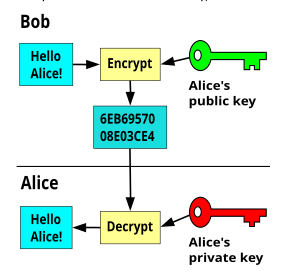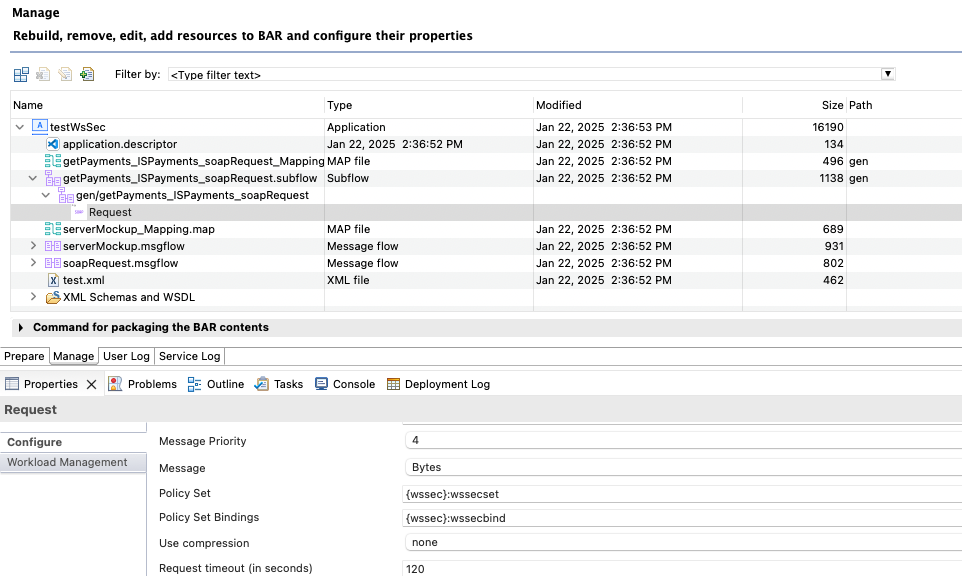Ace Wssec
Introduction
This post provides a very short summary on how to configure and deploy an ACE flow that is using WSSEC.
The example provided here is a simple flow that uses a SOAP Request node configured with a WSSEC policy to encrypt the SOAP Body.
Configuration
ACE runtime
The WS-Sec framework used by ACE still requires Java8.
You will need to specify that the integration server has to run under the JRE 8.
ibmint specify jre --version 8 --work-directory <work-dir>
ibmint display supported-jre-versions
PKI Infrastructure
A keystore and a truststore needs to be configured.
ResourceManagers:
HTTPConnector:
ListenerPort: 7800
JVM:
jvmDebugPort: 9997
keystoreType: 'JKS' # JVM key store type, can be 'JKS' or 'PKCS12'.
keystoreFile: '/Users/prichelle/Documents/workspace/ace/toolkit/toolkit_gc/TEST_SERVER/ks_aceis.jks' # JVM location of the key store
keystorePass: 'keystorePass' # JVM resource alias containing the key store password
truststoreType: 'JKS' # JVM trust store type, can be 'JKS' or 'PKCS12'.
truststoreFile: '/Users/prichelle/Documents/workspace/ace/toolkit/toolkit_gc/TEST_SERVER/ks_aceis.jks' # JVM location of the trust store
truststorePass: 'truststorePass' # JVM resource alias containing the trust store password
Credentials to the keystore/truststore can be defined using for example a VAULT.
mqsicredentials --ext-vault-dir $vkpath --ext-vault-key Passw0rd --create --credential-type truststore --credential-name keystorePass --password passw0rd
mqsicredentials --ext-vault-dir $vkpath --ext-vault-key Passw0rd --create --credential-type keystore --credential-name truststorePass --password passw0rd
Create the policySet & Bindings
This will create a policy project with the two policy sets.

SOAP Body encryption
The following configuration is provided to encrypt the soap body.
The solution provides also the possibility to encrypt only a specific field using QName or XPATH.
The flow provided is using a SOAPRequest node.
The payload is encrypted using an asymmetric cryptography with X.509 public key provided by the service to be called. The service will decrypt the payload using its private key.

The public key is hold in a certificate that needs to be made available in the ACE truststore.
Policy
Using the editor, select the policy set & binding tool:
 Add an additional policy (default can’t be edited):
Add an additional policy (default can’t be edited):

Check the message level protection:

Add a token to be used. The name is not that important, you can choose to use the same name as the alias in order to easily identify it.

<?xml version="1.0" encoding="UTF-8"?>
<policy:Policy xmlns:_0="http://docs.oasis-open.org/wss/2004/01/oasis-200401-wss-wssecurity-utility-1.0.xsd" xmlns:_200512="http://docs.oasis-open.org/ws-sx/ws-securitypolicy/200512" xmlns:policy="http://schemas.xmlsoap.org/ws/2004/09/policy">
<_200512:AsymmetricBinding>
<policy:Policy>
<_200512:RecipientToken>
<policy:Policy>
<_200512:X509Token _200512:IncludeToken="http://docs.oasis-open.org/ws-sx/ws-securitypolicy/200512/IncludeToken/AlwaysToRecipient">
<policy:Policy Name="dpgw">
<_200512:WssX509V3Token10/>
</policy:Policy>
</_200512:X509Token>
</policy:Policy>
</_200512:RecipientToken>
<_200512:AlgorithmSuite>
<policy:Policy>
<_200512:Basic256/>
</policy:Policy>
</_200512:AlgorithmSuite>
<_200512:Layout>
<policy:Policy>
<_200512:Strict/>
</policy:Policy>
</_200512:Layout>
</policy:Policy>
</_200512:AsymmetricBinding>
<policy:Policy _0:Id="request:encbody">
<_200512:EncryptedParts>
<_200512:Body/>
</_200512:EncryptedParts>
</policy:Policy>
</policy:Policy>
<_200512:RecipientToken>
Specifies the security token that the recipient must use. The recipient is expected to decrypt the message using the corresponding private key.
<_200512:X509Token>
Indicates that the X.509 certificate is used for token-based authentication and encryption.
_200512:IncludeToken="AlwaysToRecipient"Ensures that the token (certificate) is always included in the message sent to the recipient.<_200512:WssX509V3Token10>Specifies compliance with the X.509 v3 token profile defined by WS-Security.
<policy:Policy _0:Id="request:encbody">
Defines a policy for encrypting specific parts of the SOAP message.
<_200512:EncryptedParts>Specifies which parts of the message should be encrypted.<_200512:Body>Indicates that the entire SOAP body must be encrypted.
Binding:
The binding will provide information on how to get the certificate from the infrastructure:
<securitybinding:securityBindings xmlns:securitybinding="http://www.ibm.com/xmlns/prod/websphere/200710/ws-securitybinding">
<securitybinding:securityBinding name="application">
<securitybinding:securityOutboundBindingConfig>
<securitybinding:encryptionInfo name="gen_encbody" order="1">
<securitybinding:keyEncryptionKeyInfo reference="gen_dpgw_encencbody_keyinfo"/>
<securitybinding:encryptionPartReference reference="request:encbody"/>
</securitybinding:encryptionInfo>
<securitybinding:keyInfo classname="com.ibm.ws.wssecurity.wssapi.CommonContentGenerator" name="gen_dpgw_encencbody_keyinfo" type="KEYID">
<securitybinding:tokenReference reference="gen_requestencbody"/>
</securitybinding:keyInfo>
<securitybinding:tokenGenerator classname="com.ibm.ws.wssecurity.wssapi.token.impl.CommonTokenGenerator" name="gen_requestencbody">
<securitybinding:valueType localName="http://docs.oasis-open.org/wss/2004/01/oasis-200401-wss-x509-token-profile-1.0#X509v3"/>
<securitybinding:jAASConfig configName="system.wss.generate.x509"/>
<securitybinding:callbackHandler classname="com.ibm.websphere.wssecurity.callbackhandler.X509GenerateCallbackHandler">
<securitybinding:keyStore path="*MQSIBROKERSTOREPATHMQSI*" storepass="*MQSIBROKERSTOREPWDMQSI*" type="JKS"/>
<securitybinding:key alias="dpgw" name="CN=pair"/>
</securitybinding:callbackHandler>
</securitybinding:tokenGenerator>
</securitybinding:securityOutboundBindingConfig>
<securitybinding:securityInboundBindingConfig/>
</securitybinding:securityBinding>
</securitybinding:securityBindings>
The key used for encryption is identified using gen_dpgw_encencbody_keyinfo.
The key should be defifined in the soap header using a unique key identifier (KEYID).
The key is from a x509 certificate identified by an alias (here dpgw) and distinguished name (here CN=pair), which needs to be configured event though it is not used, that is stored in the integration server store.
Example of XML generated:
<?xml version="1.0" encoding="utf-8"?>
<soapenv:Envelope xmlns:soapenv="http://schemas.xmlsoap.org/soap/envelope/">
<soapenv:Header>
<wsse:Security
xmlns:wsse="http://docs.oasis-open.org/wss/2004/01/oasis-200401-wss-wssecurity-secext-1.0.xsd"
soapenv:mustUnderstand="1">
<enc:EncryptedKey xmlns:enc="http://www.w3.org/2001/04/xmlenc#">
<enc:EncryptionMethod Algorithm="http://www.w3.org/2001/04/xmlenc#rsa-oaep-mgf1p">
<ds:DigestMethod xmlns:ds="http://www.w3.org/2000/09/xmldsig#"
Algorithm="http://www.w3.org/2000/09/xmldsig#sha1"></ds:DigestMethod>
</enc:EncryptionMethod>
<ds:KeyInfo xmlns:ds="http://www.w3.org/2000/09/xmldsig#">
<wsse:SecurityTokenReference>
<wsse:KeyIdentifier
EncodingType="http://docs.oasis-open.org/wss/2004/01/oasis-200401-wss-soap-message-security-1.0#Base64Binary"
ValueType="http://docs.oasis-open.org/wss/2004/01/oasis-200401-wss-x509-token-profile-1.0#X509SubjectKeyIdentifier">
OVTXbnf1ypVOGUP+fbizdd5MyXo=</wsse:KeyIdentifier>
</wsse:SecurityTokenReference>
</ds:KeyInfo>
<enc:CipherData>
<enc:CipherValue>
TdV7bUx0tN3vMMSeRnVTS0VcWaA==</enc:CipherValue>
</enc:CipherData>
<enc:ReferenceList>
<enc:DataReference URI="#wssecurity_encryption_id_20"></enc:DataReference>
</enc:ReferenceList>
</enc:EncryptedKey>
</wsse:Security>
</soapenv:Header>
<soapenv:Body>
<enc:EncryptedData xmlns:enc="http://www.w3.org/2001/04/xmlenc#"
Id="wssecurity_encryption_id_20" Type="http://www.w3.org/2001/04/xmlenc#Content">
<enc:EncryptionMethod Algorithm="http://www.w3.org/2001/04/xmlenc#aes256-cbc"></enc:EncryptionMethod>
<enc:CipherData>
<enc:CipherValue>
R1juvdmoaEpYeRZqDwcERBQx/zlQSB1n8rd4tO8nh13qgQD0yRIDzQHxxLOCLQ+fj3yjm+xr2XfK+dJpWN8lpuTu2JyALTS9u6PnxdY8GQ==</enc:CipherValue>
</enc:CipherData>
</enc:EncryptedData>
</soapenv:Body>
</soapenv:Envelope>
Deploy the Integration Applications
The deployment of an integration application using wssec follows the steps:
- Deploy the WSSEC policy project
- Build the bar file
-
Edit the SOAP request properties in the bar file
Reference the policy set on the SOAP Request node by editing the bar file.
The policy are referenced with{myPolicyProject}:policyset/bindingwhere policyset is for example “wssecset” when the policy file name is “wssecset.wssecpolicy.xml” and binding is for “wssecbind” if the policy binding file name is “wssecbind.wssecbindings.xml”:

- Deploy the flows using the bar file.
Example
A very simple example is provided as a project interchange.
The project interchange contains
- an application exposed as simple HTTP that is using a SOAP Request configured using a wsdl. The soap request node is calling another ACE HTTP flow.
- another ACE application is configured with an HTTP Iinput that trace the request and send back a soap message using a mapping node.
- The message generated by the SOAP Request node can be seen in the trace.
The first flow can be called using
curl localhost:7800/callWS

